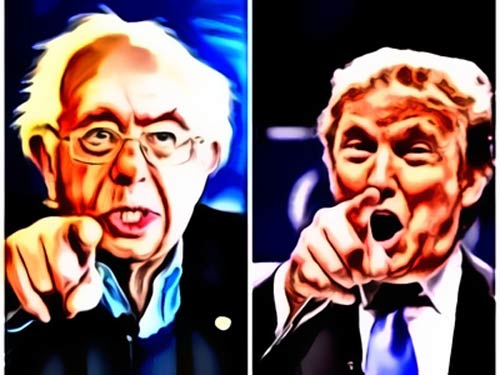
Even if Bernie Sanders and Donald Trump don't win the presidency, their candidacies have roiled the waters of American party politics. Within the GOP, those white voters who began migrating from the Democrats 50 years ago have become restive. On the Democrats' side, young voters are repudiating the "third way" politics favored by party elites. Are these fleeting disturbances, or do they suggest that some dramatic change is in store for U.S. political parties?
To answer that question, it helps to look backward. In 1932, GOP ineptitude in the face of the Great Depression turned a solidly Republican majority into a Democratic one. After World War II, political scientists developed a theory of realignment to explain the shift. A succession of writers has attempted to refine and adapt that theory to analyze the development of American politics. It's a useful way to understand the current eruptions.
The theory was born 60 years ago, in a paper by Harvard political scientist V.O. Key. In 1955, Key demonstrated that the Democratic realignment of 1932 had been anticipated by the "critical" 1928 presidential election, when Democrat Al Smith won urban, working-class parts of New England that had previously gone Republican. The predominately Catholic voters in these places would subsequently flock en masse to the Democrats. Key was among the first political scientists to document that a shift of ethnic and class voting blocs from one party to another (or the emergence of new voting blocs) could create the basis for party realignments.
In 1967, MIT political scientist Walter Dean Burnham built on Key's work. In "Party Systems and the Political Process," Burnham laid out a new theory of realignments, suggesting that they're cyclical and strike every 30 to 40 years. He called them "America's surrogate for revolution." They could be foreshadowed by Key's critical elections, but were precipitated by wars or depressions that exposed the inadequacy of prevailing party ideologies.
During the Nixon years, Kevin Phillips applied the theory to what was going on around him. In "The Emerging Republican Majority," the young Nixon administration operative wrote in 1969 that a realignment would displace the Democratic majority. Citing election data from the 1968 presidential contest, he argued that Southern and northern ethnic white Democrats, alienated by their party's support for the civil rights revolution, were eventually going to give the Republicans a new majority. His idea was brushed off after Democrats won back the White House in the wake of Watergate. But soon after, Phillips's prediction came to pass.
In 2002, Ruy Teixeira and I wrote a sequel to Phillips' theory called "The Emerging Democratic Majority." We argued that the movement of women and professionals into the Democratic Party, along with growing support from minorities, was laying the basis for a Democratic majority - not of New Deal proportions but similar to the Republican tilt of the prior decades. In the wake of Republican successes after 9/11, the book was greeted with disbelief.
But by 2008, the trends we described had helped Democrats recapture the Congress and the White House. Since then, this coalition has helped Democrats retain the White House, but not Congress or most statehouses.
That suggests the two parties, as Burnham wrote later, are in a state of "unstable equilibrium," where majorities created by "wave" elections can prove fleeting, and where Democrats enjoy an edge in presidential years, but Republicans in midterms.
This year's election may not realign the parties, but it could be one of Key's "critical" contests. Trump has disrupted the GOP coalition of downscale Reagan Democrats and the Republican business class. Similarly, Sanders's support suggests a growing Democratic division over the party's subservience to Wall Street and Silicon Valley on economic issues.
Where this could lead is anybody's guess, but I can think of several possibilities.
Most likely, a Trump loss at the hands of Hillary Clinton would simply reaffirm the status quo of an unstable equilibrium, as Republicans, chastened by their defeat, move to the center. With Congress predictably deadlocked, the White House embattled and turnout low, the Republicans could regain their momentum in the 2018 midterms.
It's also possible that Trump's candidacy could revive and strengthen the trends of 2006 by invigorating and expanding the support Democrats have enjoyed from Hispanics and women. The Dems could maintain and enlarge their coalition while the Republicans remain deeply divided. Something like that happened in California after Republicans alienated Latino voters in 1994. The GOP might still temporarily control the House but would be shut out of the presidency and the Senate for years to come.
A Trump victory in November, made possible by a sweep of the industrial Midwest, would probably lead to a reversal of the first scenario: As Republicans feuded, Democrats would be able in 2018 to recoup their losses.
But Trump's success among economically disadvantaged whites and Sanders's popularity with a new generation of debt-laden college students could foreshadow the kind of left-right realignment that took place in the 1930s, when the great preponderance of working- and middle-class voters became concentrated in one party. That would require either Republicans to court lower-income blacks and Latinos, or Democrats to replace their emphasis on race and gender with a Sanders-like emphasis on class.
It's not likely in either case, but stranger things have occurred in American political history.
Comment by clicking here.
Judis is writing a book, "The Populist Explosion: How the Great Recession Transformed American and European Politics."


Parks,Christopher.jpg)
 Contact The Editor
Contact The Editor
 Articles By This Author
Articles By This Author